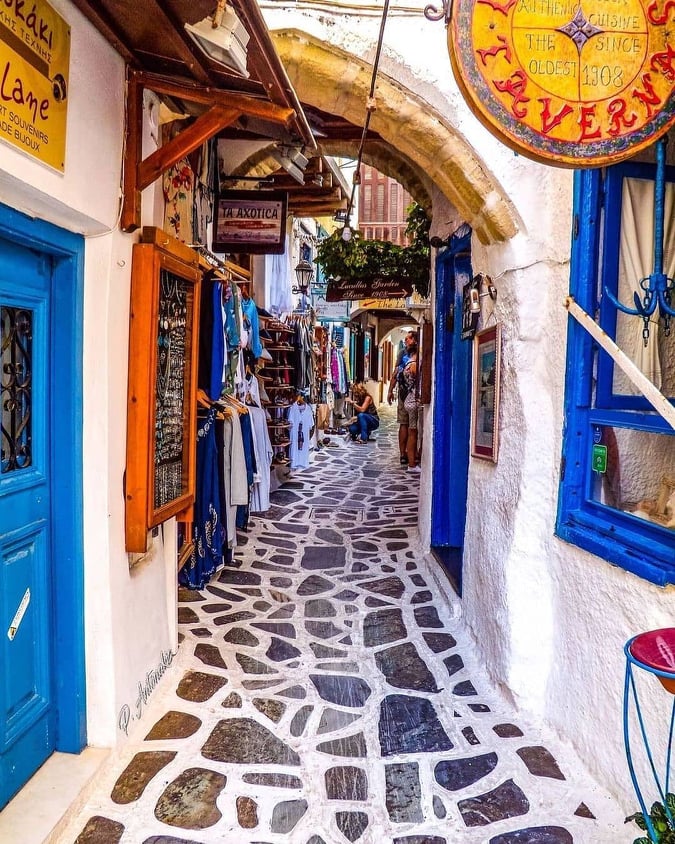
You are using the Free Edition of NaxosAPP. For extensive information on Naxos, GO PRIME with our comprehensive Greek Travel App featuring the full editions of Naxos and 25 more Greek islands & Athens.
If you arrive by ferry one the first things you will see is the ancient Portara, which in Greek means “big door” and the picturesque capital of Naxos beyond it. Nudge your way through the crowd disembarking from the daily ferry, traverse a boardwalk where dried octopus dangles from awnings and step into a whitewashed labyrinth of cobblestoned alleyways opening onto shops and outdoor restaurants. You’ve arrived in the main town of Naxos known as Chora (pronounced ‘hora’, it’s the Greek word for town) with influences of architecture and history covering centuries on end …
The old town has a mystifying labyrinth of cobbled alleys and courtyards. Just getting lost in the cobbled streets of the Chora can make for a good time with something interesting around every corner. There are a maze of stairways, passages and alleys to explore among the Cycladic structures, with shops selling handmade items like jewellery, works of art and replicas of prehistoric Cycladic figurines. Take a break occasionally to enjoy coffee or another beverage in one of the enticing cafes, soaking up the magical atmosphere. The old town is a hive of activity at night – don’t be too surprised to turn a corner to find an eccentric artist painting on a multicolored easel under a dim lamp light.
Just above the whitewashed buildings of the old town, take a walk through time and discover the hidden world of the Kastro (castle). It was built by Venetian Emperor, Markos Sanoudos II in 1207 as a protective shield to the fortress and was the seat of power in the Cyclades for 300 years. The most remarkable feature of the castle is its pentagonal shape. It had three gates, two of which still exist today: Paraporti, its southern gate and main entrance for visitors; the northern entrance, or renowned Trani Porta; and a southeastern gate, Piso Paraporti, which has not been saved. Passing through the surviving gates one enters a world of tranquility, narrow alleys, courtyards adorned with flowers, and old mansions with coats of arms on their lintels.
Within the castles inner walls are a number of Venetian residences, a 13th Century Catholic Cathedral, and the French School where Nikos Kazantzakis, Greece’s greatest modern writer who wrote among other things, Zorba the Greek and The Last Temptation of Christ, studied. The building is now the Archaeological Museum which contains some fine examples of white marble figurines and ceramics. The castle has been continually inhabited since it was built and during the summer hosts concerts and exhibitions which are advertised around the town on posters and brochures. The Kastro originally had several towers of which one remains, called the Glezos Tower which was restored in 1968 after being donated to the National Archaeology Ministry by its owner Petros Glezos.
The area called The Bourgos is where the Greeks lived when the Venetians controlled the town and its winding streets are full of restaurants and shops. The northern part of Naxos town is called Grotta and has a pebble beach which is not used much since the northern winds make it pretty rough and difficult for anyone but the best swimmers, body surfers and wind surfers. However when there is no wind and it is calm it can be very pleasant. There is an archaeological site here that is open to the public. The southern part of Naxos town is Agios Georgios Beach which is very popular and has a number of hotels, cafes, restaurants and bars. The harbour itself is a lively area of cafes, restaurants, travel agencies, ATM’s and shops.
It’s easy to combine history and culture with a bit of sightseeing and sunset viewing all in one free self-guided excursion just a few minutes’ walk from Naxos Town. All you have to do is take an evening stroll along the short causeway leading to the peninsula on the edge of town (an area known as the Palatia district). Climb the hillside and you’ll find yourself on one of the island’s best sunset viewing spots, right next to one of the most famous monuments on the island – the giant stone door frame known as the Portara.
Sorry, no records were found. Please adjust your search criteria and try again.
Sorry, unable to load the Maps API.
[gd_maps]
